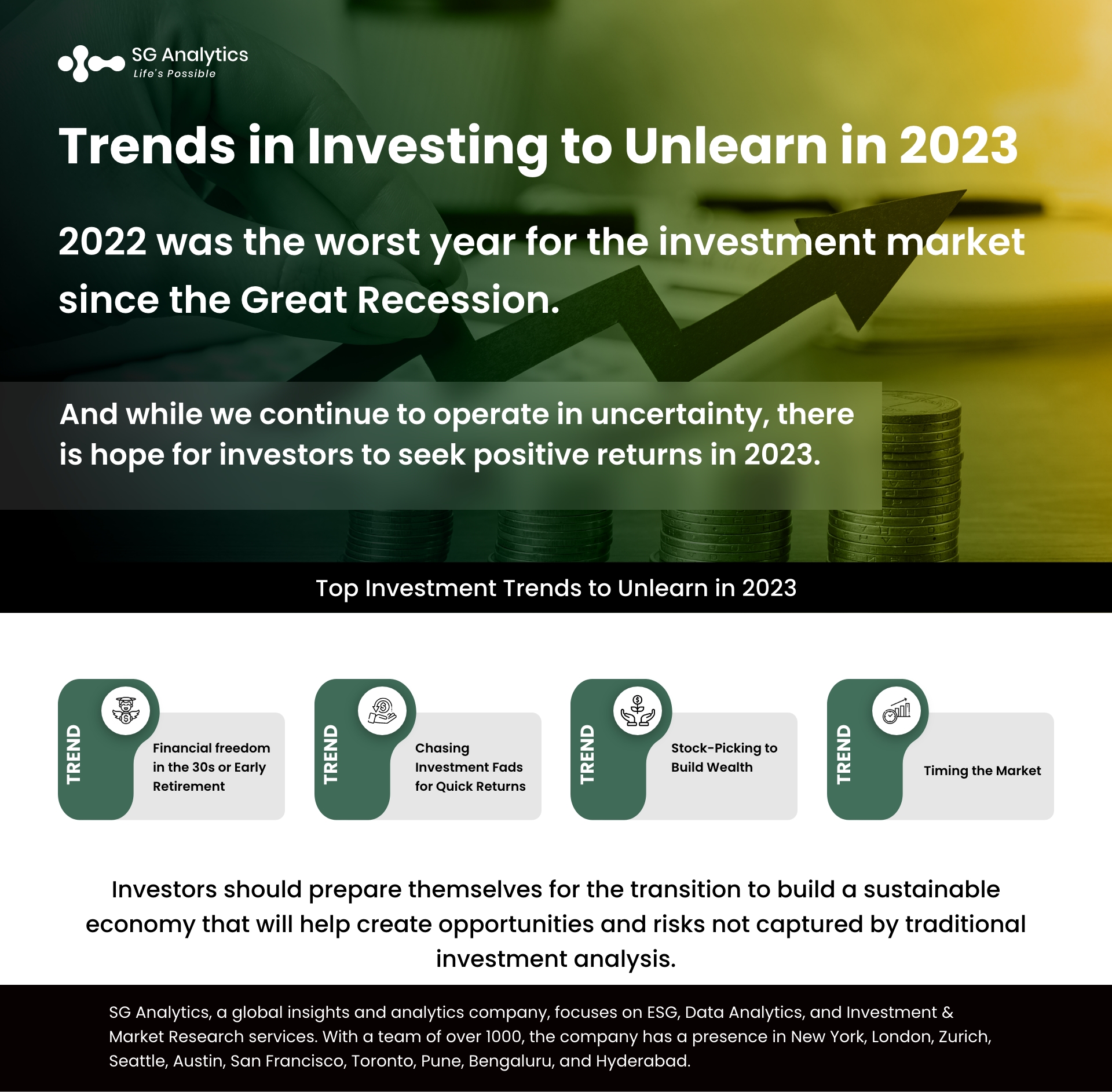While in 2020 and 2021, industries experienced boom years, with gold, equities, blockchain, real estate, commodities, and cryptocurrency. With solid returns, investors were perceiving these good times to induce complacency, which led to a misplaced sense of confidence. This results in the widespread adoption of narratives and investing trends, initiating a catastrophic impact on investor wealth.
But 2022 presented a different picture. Technological disruptions started affecting every industry, and learning processes were also changing. While technology was transitioning quickly, resources were limited. Investment professionals were being compelled to deliver more insight and analysis within limited time frames. This profusion of change mandated professionals to stay abreast of the transformations and be able to identify and quantify the impacts to make an insightful decision.
Today the investment and finance industry are grappling with how to infuse activities with the greatest potential returns. Organizations are identifying investment options to invest in developing solutions for their customers. In this age of transparency, stakeholders demand better corporate accountability, as investors want their investments to make a difference. Industry leaders believe that the losses in 2022 can be considered a blessing in disguise. They provided some sobering lessons and pivoted the spotlight to some investing trends that investors must unlearn in 2023.
Read more: How Fintech Companies are Revolutionizing B2B Payments

Top Investment Trends to Unlearn in 2023
2022 was the worst year for the investment market since the Great Recession. And while we are still continuing to operate in uncertainty, there is a ray of hope for investors to seek positive returns in 2023.
Trend #1: Financial freedom in the 30s or Early Retirement
Financial freedom before you hit your 30s or early retirement is on the horizon. Unless you have a unicorn startup in your 20s, there is no way of attaining this financial freedom in your 30s or option for early retirement. These impractical dreams are compelling investors to put the bulk of their earnings in high-risk instruments such as cryptos and NFTs and chase near-impossible returns, thereby having a catastrophic impact on their finances. In a rather practical world, financial freedom can be achieved through the following:
-
Investing 100% of your efforts into the workplace and striving for higher incomes.
-
Save and invest almost 40-50% of monthly income in the core portfolios.
-
Invest in portfolios that present top asset allocation models. It is important to select asset allocation models based on risk profile. These portfolios protect investors against adverse risks, thus maximizing the return potential.
With these steps, one can aim to achieve financial freedom over the course of their life with sufficient allowances for responsibilities.
Read more: Ways Private Equity and Venture Capital Firms can Protect Themselves from Cyber Risks

Trend #2: Chasing Investment Fads for Quick Returns
Interestingly, very few investors comprehend crypto and are willing to enter the crypto and blockchain realm due to its social media buzz. In the last year, cryptocurrencies ended up losing 60-90% of their market value. One more relevant example can be the IPO of new-age tech companies, as their market value fell just a few months after listing. It is, therefore, vital for investors to be aware of the possible returns and not just follow the trends blindly. As every fad often results in unsustainable bubbles that can wipe out investor wealth quickly.
Trend #3: Stock-Picking to Build Wealth
The success stories of different financial institutions have paved the way to give mainstream credence to the theory of building abnormal wealth by identifying multi-bagger options in the market. However, one thing people are not aware of in these success stories is the wealth destruction suffered by the investors at different points in time. With inflation and other crises creating losses for investors, it is important to understand the higher probability of picking funds or other options that yield profits. However, stock picking mandates extensive professional training as well as ample time to evaluate business opportunities.
Trend #4: Timing the Market
The market cap of companies is expected to grow from $3 trillion to $25 trillion by 2035. Entering the market at lower levels can often account for a fraction of additional gains. However, there are no substantial benefits to trying to time the market. For solid long-term prospects, instead of timing the current market, it is important for investors to explore regular options or mutual funds without exception.

While the market is offering much better returns over inflation than last year, investors believe they are still in uncharted territories. The persistence of inflation is expected to be higher than the markets, and investors are predicting that government bonds aren’t a good place to be, but corporates are.
Read more: Fintech in the US: The Top 8 Players to Look Forward to in 2022
Ability to Learn, Unlearn, and Relearn
Investments mandate understanding the business along with undertaking an in-depth financial analysis. Today financial analysts are quickly coming up to the speed of the changing investment landscape along with understanding how apps are built, what is the cost for maintenance, as well as the expected impact of the changes. With the rise of agile technology and development in the financial sector, the speed of incorporating new innovations is also accelerating.
In this environment, financial institutions are continually learning about the new developments that affect industry to calculate various financial effects and track performance. However, this experience requires more collaboration and interaction with other departments, along with greater participation in strategic decision-making. It is especially important for professionals to master the following skills to navigate this environment successfully:
-
Capability to Learn
Investment professionals are good at learning and applying their financial proficiency to the business. However, the need today is to learn quickly and go beyond the traditional business framework about the new developments and their impact. This implies interacting with industry peers and understanding how other enterprises are addressing similar issues and staying updated with the latest trends.

-
Unlearning Existing Components
One of the biggest differences for financial institutions is not only their ability to learn but also to unlearn. Investment analysts are amazingly comfortable using traditional methods of operations to manipulate data, as they are accustomed to the transparency it provides. However, it is important for them to understand and learn advanced analytics along with automated reporting systems and unlearn their distrust of traditional reporting. They need to incorporate advanced analytics into their reporting and dashboarding as the premier skills. The skills are still important if they want to move to advanced analytics.
-
Relearn New Methodologies
Investment analysts should be ready to understand and incorporate innovative technologies and experiment with different methodologies. To be part of the future transition in their organizations, industry leaders need to introduce the requirements of different organizational roles to every business transformation discussion. They should also design new strategies that align with their vision of this approach. This will involve relearning how the traditional framework within the company operates with additional time for advanced analytics. They must also understand and incorporate data governance, partnering with data science and statisticians.

Read more: Forecast: Top Venture Capital Market Trends In 2023
Headwinds for 2023 and Beyond
The financial sector is further exacerbated due to an increase in skeptical rhetoric around the merits of investment opportunities that are likely to continue due to greater pushback. This less supportive environment impacts passive funds management that relies on third-party scores or company portfolios. Sustainable investing and ESG factors have also become a critical part of every investment over the past few years. The growth has been spurred by the demand to consider nonfinancial risks that pose problems such as climate change, resource depletion, treatment of workers throughout the organization, corporate ethics, and wealth inequality.
But this does not imply that investors should abandon ship. Instead, they should prepare themselves for the transition to build a sustainable economy that will help create opportunities and risks not captured by traditional investment analysis.
With a presence in New York, San Francisco, Austin, Seattle, Toronto, London, Zurich, Pune, Bengaluru, and Hyderabad, SG Analytics, a pioneer in Research and Analytics, offers tailor-made services to enterprises worldwide.
SG Analytics, an investment research conpany assists in strengthening investment decisions by leveraging custom research support. Contact us today if you are in search of an investment research firm that offers tailored research support across a broad range of asset classes.









